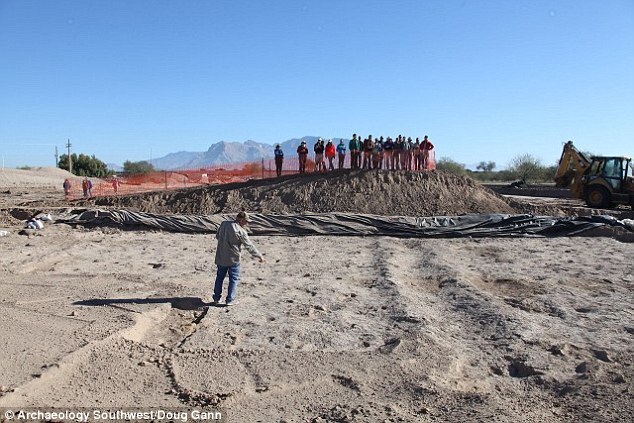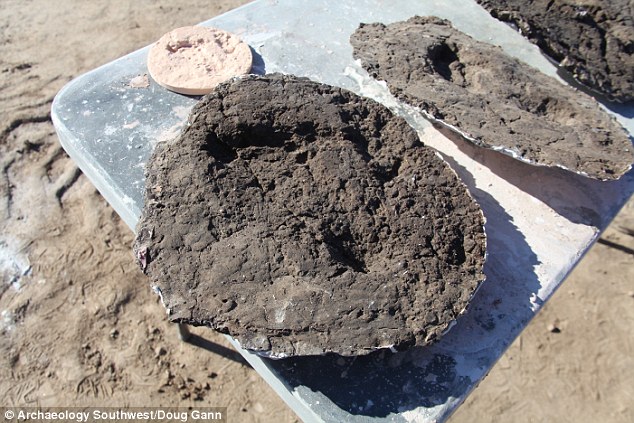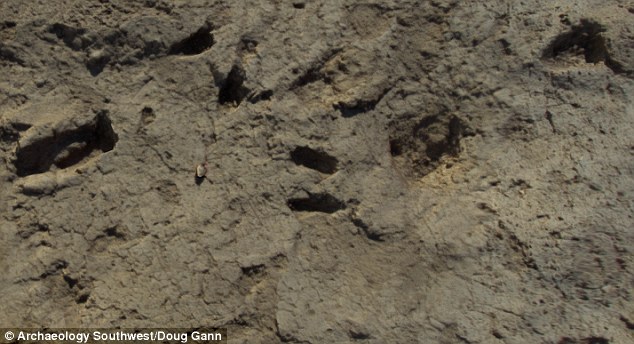Just recently, archaeologists discovered something absolutely amazing – tracks that appear to have been made by a farming family in Tucson, Arizona. These people walked on earth over 2,000 years ago.
There are footprints from farmers, their children, and even their dog. It appears they wandered through fields on this site. The prints were found as plans were being made to build a new highway in the area.
Those footprints are frozen pieces in time, that tell of what the Native Americans in the area did at that period. They were imprinted in thick mud and well-preserved when a flash flood covered the area in sediment, forming a hard crust over the prints. Archaeologists can now see how these Native Americans lived and grew their crops. They also believe that these prints were made by some of the earliest farmers in North America.

It is still not clear exactly who the family was, but it is believed they were ancestors of the Hohokam culture, which later emerged in the region around the Santa Cruz River. They are known as farmers who relied on irrigation canals to water their crops. The Hohokam generally cultivated cotton, tobacco, maize, beans, and squash. They also made red clay pottery. It is thought that they emerged around 300 AD, before disappearing around 1450 AD.
The Sunset Prints show adults, children, and pets in the field where there were networks of irrigation channels. Planting holes left by crops were also preserved in the mineralized mud. This could also provide clues as to what kind of crops were planted in that general area.
The tracks show the farmers treading heavily and slowly across the fields as the children ran around them, with their dog following. In another area, one of the parents appeared to have stopped to pick up a child before setting it back down again. Alongside these footprints is a handprint of a young child.
Archaeologists are still making more discoveries and unearthing more footprints. The excavation is being done by S.W.C.A. Environmental Consultants. They are studying the field, which is due to be destroyed to make a bridge for a nearby highway.

Doug Gann, a preservation archaeologist for Archaeology Southwest, has been using advanced 3D scanning to record the prints before the area is cleared. He said that working with the footprints gives him an intimate feeling of the people who once stood there. He added that he has been working in archaeology for 30 years and these footprints brought him to tears. He said they are not merely footprints, they are the markers of what used to be there and the people who lived there. He believed that that particular day must have been quite wet in order to make so many tracks.
Around 4,300 square feet of the prints have been exposed so far. They had uncovered tracks of men, women, children, and dogs while examining the site for Pima County under the National Historic Preservation Act. Dan Arnit, an archaeological excavator, was the first person to spot the tracks. As workers removed dusty soil, they were able to follow the footprints along. They also uncovered irrigation channels, earthworks, and ditches which would have been used to keep the fields watered.
One set of prints appears to walk diagonally across the field and stop to do some work in a ditch before continuing. Another footprint has a dog’s paw print inside, showing that the animal followed its master. The small prints of a child allow archaeologists to see just how it interacted with its parents.
Although these prints are not the oldest that have been found – the oldest are more than 13,000-years old – they are among some of the most detailed and reveal just how farming was done 2,500 years ago.

Source: Archeology Southwest
Gann explained that the prints show that the people were moving from canal to canal to build thick mud dams for diverting a surplus of rain and river water to their corn plants. The archaeologists uncovered cats’ paw prints as well. They hope to incorporate some of them in the new bridge designs.
Gann added that the findings are so new that the scientific archaeology community has not had time to provide them with a name yet. He is hoping that there are more footprints in other areas that were once fields. The work is still being continued today.